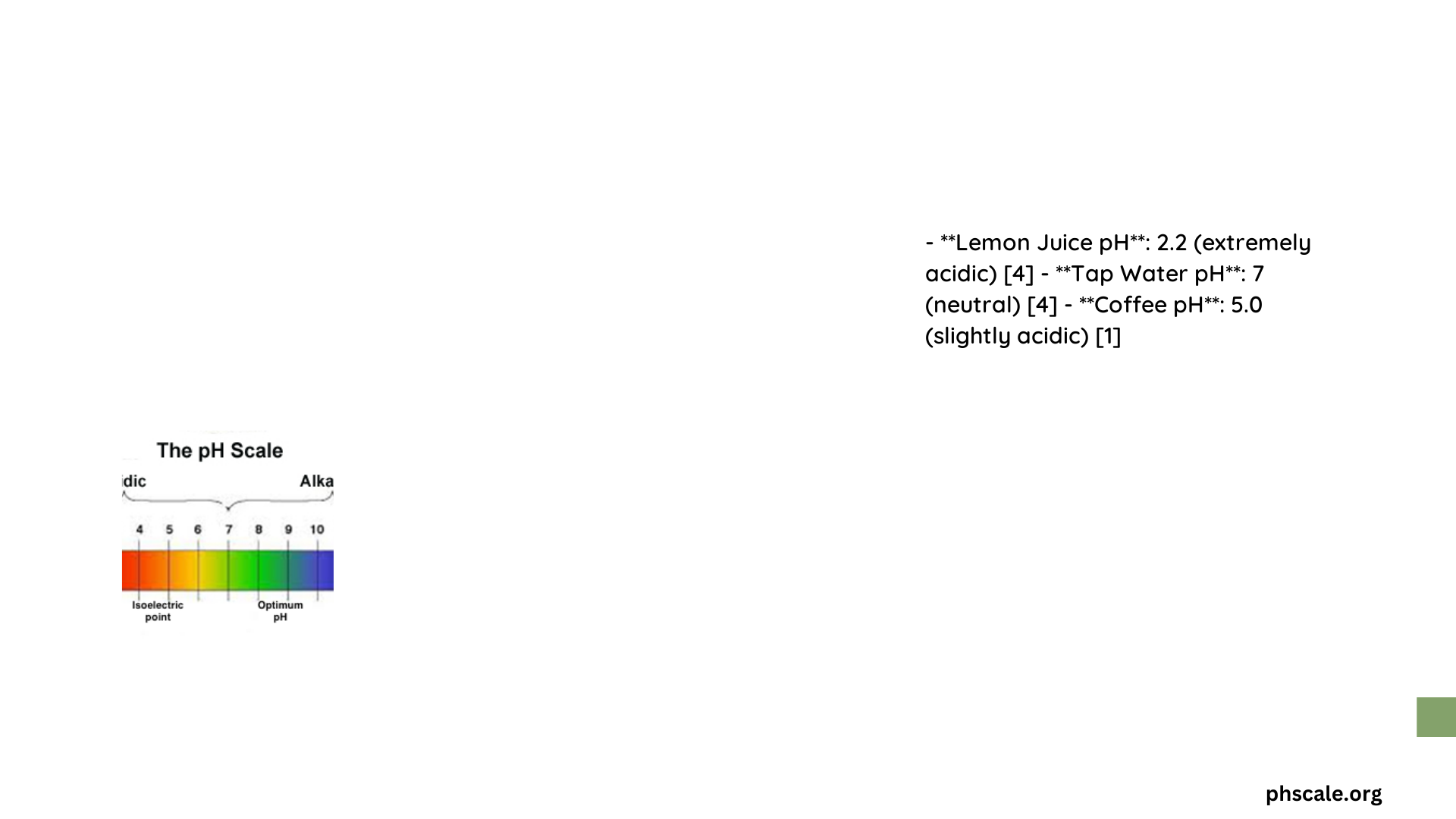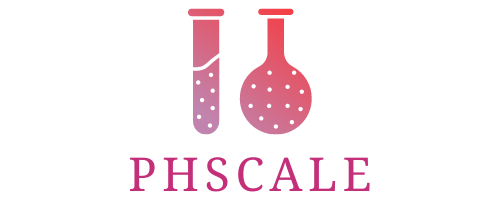The pH scale measures the acidity or alkalinity of substances, ranging from 0 (most acidic) to 14 (most alkaline). Lemon juice, tap water, and coffee have distinct pH levels that affect their taste, properties, and interactions with our bodies. Lemon juice is highly acidic with a pH between 2.0 and 3.0, tap water is generally neutral with a pH around 7.0, and coffee is mildly acidic with a pH between 4.5 and 6.0.
What is the pH Scale and How Does it Work?
The pH scale is a logarithmic measure of hydrogen ion concentration in a solution. It ranges from 0 to 14, with 7 being neutral. Values below 7 indicate acidity, while values above 7 indicate alkalinity. Each unit change on the pH scale represents a tenfold change in acidity or alkalinity.
- pH 0-6.9: Acidic
- pH 7: Neutral
- pH 7.1-14: Alkaline (Basic)
What is the pH of Lemon Juice?

Lemon juice is known for its high acidity, which contributes to its tart flavor and preservative properties. The pH of lemon juice typically falls between 2.0 and 3.0, making it one of the most acidic common foods.
Factors affecting lemon juice pH:
1. Ripeness of the lemon
2. Lemon variety (e.g., Meyer lemons vs. commercial lemons)
3. Age of the lemon
4. Storage conditions
| Lemon Type | Typical pH Range |
|---|---|
| Commercial Lemons | 2.0 – 2.6 |
| Meyer Lemons | Around 2.6 |
The high acidity of lemon juice is primarily due to its citric acid content. This natural acid gives lemons their characteristic sour taste and also acts as a preservative, inhibiting the growth of bacteria and other microorganisms.
What is the pH of Tap Water?
Tap water generally has a pH close to neutral, around 7.0. However, the exact pH can vary depending on several factors:
- Water source (e.g., groundwater, surface water)
- Treatment processes
- Mineral content
- Local regulations
In most urban areas, tap water pH is regulated to fall within a range of 6.5 to 8.5. This range is considered safe for consumption and helps prevent corrosion of pipes and plumbing fixtures.
Factors influencing tap water pH:
– Presence of dissolved minerals (e.g., calcium, magnesium)
– Type of disinfection used (e.g., chlorine, chloramine)
– Environmental factors (e.g., acid rain)
It’s worth noting that while tap water is generally close to neutral, it can become more acidic when exposed to air due to the absorption of carbon dioxide, which forms carbonic acid.
What is the pH of Coffee?
Coffee is mildly acidic, with a pH typically ranging from 4.5 to 6.0. The exact pH can vary based on several factors:
- Coffee bean variety
- Roast level
- Brewing method
- Water quality used for brewing
| Brewing Method | Typical pH Range |
|---|---|
| Drip Coffee | 5.5 – 6.0 |
| French Press | 4.5 – 5.5 |
| Espresso | 5.0 – 5.5 |
The acidity in coffee comes from various organic acids, including:
– Chlorogenic acid
– Quinic acid
– Citric acid
– Acetic acid
These acids contribute to coffee’s complex flavor profile, providing brightness and fruitiness to the brew.
How Do the pH Levels of Lemon Juice, Tap Water, and Coffee Compare?
When comparing the pH levels of these three common beverages, we can see a significant range:
- Lemon Juice: pH 2.0 – 3.0 (Highly acidic)
- Coffee: pH 4.5 – 6.0 (Mildly acidic)
- Tap Water: pH 6.5 – 8.5 (Near neutral)
This comparison illustrates the vast differences in acidity between these everyday liquids. Lemon juice is approximately 10,000 times more acidic than tap water, while coffee is about 10 to 100 times more acidic than tap water.
What Are the Implications of These pH Levels?
The pH levels of these beverages have various implications for health, taste, and practical applications:
Lemon Juice (pH 2.0 – 3.0):
- Highly effective natural preservative
- Can erode tooth enamel if consumed frequently
- Used in cooking to prevent browning of fruits and vegetables
- Can be used to clean and disinfect surfaces
Tap Water (pH 6.5 – 8.5):
- Safe for consumption and general use
- Suitable for most household appliances
- Helps maintain proper hydration without affecting body pH significantly
Coffee (pH 4.5 – 6.0):
- Mildly acidic taste contributes to flavor complexity
- May cause acid reflux in sensitive individuals
- Can stain teeth over time due to its acidity and color compounds
How Can pH Levels Be Measured Accurately?
There are several methods to measure pH levels accurately:
- pH Strips: Color-changing paper strips that provide a quick estimate of pH.
- Digital pH Meters: Electronic devices that offer precise pH measurements.
- Litmus Paper: A simple method that indicates whether a substance is acidic or alkaline.
- Phenol Red: A chemical indicator used primarily for testing pool water pH.
For the most accurate results, digital pH meters are recommended, especially when precise measurements are required.
What Are Some Common Misconceptions About pH Levels in These Beverages?
-
Myth: Lemon juice is alkaline in the body.
Fact: While lemon juice may have an alkalizing effect after metabolism, it is highly acidic when consumed. -
Myth: All coffee is highly acidic.
Fact: Coffee acidity varies greatly depending on the bean, roast, and brewing method. -
Myth: Tap water is always neutral (pH 7).
Fact: Tap water pH can vary and is often slightly alkaline due to treatment processes.
How Do pH Levels Affect Taste and Flavor?
The pH levels of beverages significantly impact their taste and overall flavor profile:
-
Lemon Juice: The low pH contributes to its sharp, sour taste. This acidity is what makes lemon juice an excellent flavor enhancer in many dishes.
-
Tap Water: Ideally, water should have a neutral taste. However, slight variations in pH can affect the perception of ‘freshness’ or ‘crispness’ in water.
-
Coffee: The acidity in coffee is crucial for its flavor complexity. It contributes to the ‘brightness’ or ‘liveliness’ of the brew. However, overly acidic coffee can taste sour or harsh.
What Are the Health Implications of Consuming These Beverages?
Understanding the pH levels of these common beverages can help us make informed decisions about our diet and health:
- Lemon Juice:
- High in vitamin C
- Can aid digestion
-
May erode tooth enamel if consumed excessively
-
Tap Water:
- Essential for hydration
- Neutral pH is generally safe for consumption
-
Minerals in water can contribute to daily nutrient intake
-
Coffee:
- Contains antioxidants
- May cause acid reflux in some individuals
- Can stain teeth over time
It’s important to note that while these beverages have different pH levels, our body’s buffering systems maintain a stable internal pH. However, excessive consumption of highly acidic beverages may have long-term effects on dental health.
In conclusion, understanding the pH levels of common beverages like lemon juice, tap water, and coffee can provide valuable insights into their properties, flavors, and potential health effects. While pH is an important factor, it’s just one aspect to consider when making dietary choices. As always, moderation and balance are key to a healthy diet.
References:
1. YouTube: pH of Lemon Juice
2. Healthy Canning: The Acidity of Lemons and Home Canning
3. Healthline: Lemon Juice: Acidic or Alkaline, and Does It Matter?
